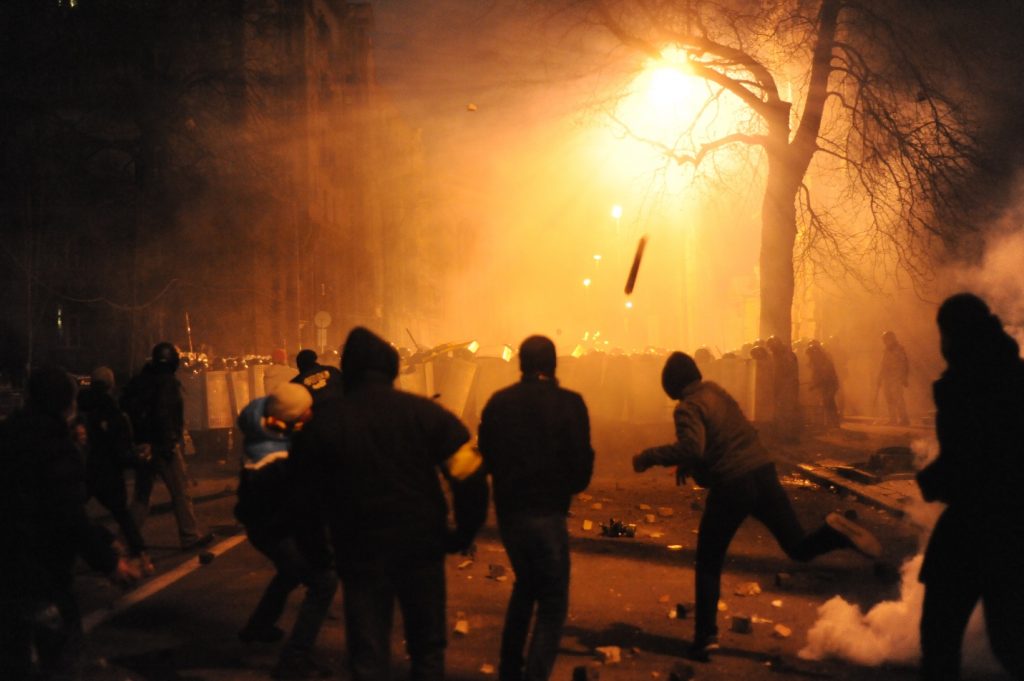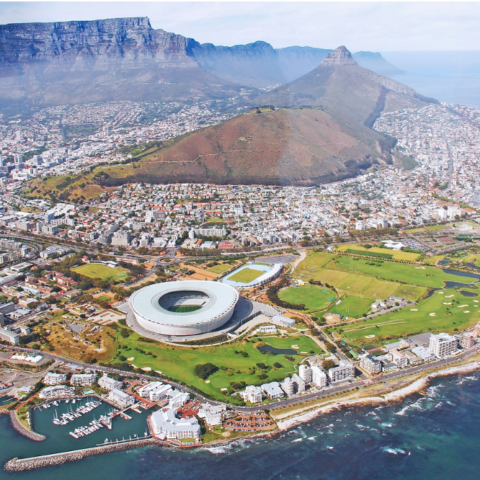By: Michael Ingram

(Wikimedia Commons)
It is Jan. 23, 2014, 3 a.m. EST. The droning cacophony of police bullhorns breaks the early morning stillness in the frost-covered Ukrainian capital of Kiev. Protesters pace aimlessly between makeshift barriers constructed from the requisitioned flotsam of the city streets and the burn-out carcasses of buses. With shields raised, state security forces form a bulwark against any advance. They begin drowning out the cries of dispersal from the loudspeakers by beating their shields in unison – a modern version of the Roman Praetorian Guard. An unknown man stands brazenly on top of the improvised parapet, proudly waving a Ukrainian flag in defiance. A flock of birds soars above Independence Square, indifferent to the political struggle below.
This was my first taste of the revolution in Ukraine, a nation of 46 million which straddles the line between Western and Eastern Europe. In the days since the Livestream first went online (and subsequently offline), the reality on the ground has grown ever more chaotic. The protests began in earnest as a response to President Yanukovych’s rejection of economic integration with the European Union. Instead, he had elected to take a path weighted heavily in favor of Russia. Despite the apparent push and pull of external power politics between the EU and Russia, Ukrainians are now revolting for themselves. On Jan. 16, the Verkhovna Rada, the unicameral parliament of Ukraine, passed sweeping legislation aimed at eliminating any popular capacity for opposition. The Ukrainian people viewed the anti-protest laws simply as a casus belli to protect basic political freedoms and remove a corrupt, power-hungry government.
The new restrictions read as any dictator’s wish list. Mass disruptions (read: non-violent protest) carry a sentence of up to 15 years in prison. Riot officers and officials committing crimes against protesters risk no punitive action. The government can suspend all internet activity at will. Even wearing a helmet at a peaceful gathering is considered grounds for arrest. President Yanukovych and parliament saw these changes as essential to maintaining their preferential power structure in Ukraine, and so they were passed without the consent of the people.

(CHESNO)
In the absence of an independent judiciary to overturn the blatantly authoritarian decrees, the Ukrainians initiated what some analysts have referred to as the Orange Revolution Redux. The moniker is in reference to the successful uprising against government-curated mass voter fraud in the 2004 presidential election. With the anti-protest laws seen as a license to retaliate against state security apparatuses, rioter officers elected to answer all shows of resistance with force. Protestors first began launching Molotov cocktails at the police to break free of their quarantine, but now the riot police are flinging bottles of flammable liquid back. This Orange Revolution has become stained with blood.
However, owing to the volatile nature of the revolt, there are initial inclinations that this blood has not been shed in vain. Popular support for the opposition and unenthusiastic backing from pro-government forces (if one does not count paid thugs, the Titushky) means President Yanukovych has been inundated with pressure. The unaccepted offer of the position of Prime Minister to opposition leader Arseniy Yatsenyuk failed to end the calamitous riots and take-overs of government buildings, but the recent retraction of the anti-protest laws could bring some de-escalation of violence to the rattled nation.
In a promising turn of events, Prime Minister Mykola Azarov vacated his premiership on Jan. 28. Whether or not the parade of concessions and disavowal of undemocratic laws will end the two-month-long occupation of Maidan Nezalezhnosti (Independence Square) and, more recently, Hrushevskoho Street, remains to be seen. The opposition could just as easily interpret these compromises as the initial cracks in the façade of a government entering its inevitable death throes. The recent rounds of concessions expose a government only willing to capitulate when the writing is on the walls. Vast public frustration now remains focused on the removal of President Yanukovych and a new round of elections.
In the West, the media has drastically oversimplified the dramatic events pouring out from Kiev, and, on a lesser scale, from other major population centers. The new Orange Revolution is a much different animal from its predecessor in 2004; the new revolution dwarfs the old in its scope and desired outcomes. Most importantly, these differences are muted in light of Western media’s lack of proper analysis. In order to best aid the democratic transition of Ukraine, the American people must discern the true course of the crisis from unfounded rumor.
In particular, the word “revolution” poses problems for correctly interpreting the crisis in Ukraine. Revolution is associated in the West with a complete restructuring of the state and often by widespread, violent means. The notion that Ukraine is splitting at the seams is premature. Part of this problem comes from Western understandings of the divisions within the country. The common refrain suggests that Ukraine is split between the European-leaning western half of the country and the pro-Russian east. While electoral data from the 2004 and 2010 presidential elections depicts this division, such infographics and assumptions lack the subtlety necessary for reasonably examining such a large and diverse state as Ukraine.
The main impetus for revolution comes from the younger generations and the highly educated, not necessarily pro-European blocs within the state. This distinction is important because it changes the narrative for the revolution. This is not a civil war between pro-EU versus pro-Russian factions; rather it is between disenfranchised citizens and their corrupt government. There is no illusion that this would be a disastrous scenario. Even more disconcerting is the likelihood that, in the event of a civil war, Russia would intervene on behalf of its embattled sidekick Yanukovych. Russia has made no illusions about its desire to retain Ukraine firmly inside its sphere of influence, and a civil war would be a prime opportunity to put troops into the country in the name of stability rather than imperial ambition.
In the Arab Spring, revolutions were seemingly hijacked from secular protestors that spawned the dialogue of change. Islamists were able to subvert democratic groups through their disciplined organization and mass support. Western media has implicitly noted an analogue of the well-organized Islamists in the presence and discipline of far-right groups in Ukraine. The possibility of Svoboda, the right-wing nationalist party of Ukraine, emerging from the fray and claiming power is a worrying prospect indeed.
However, any notion of Svoboda seizing power in the same fashion as Islamists ignores the reality of their capabilities. Whereas Islamists had the support of millions of religious conservatives in countries where authoritarianism worked to diminish the influence of Islam, Svoboda is a fringe party with a membership of only around 15,000. Fortunately, too, most Ukrainians do not want to return to the days of Nazi occupation, unlike Islamist supporters who wanted to replace autocracy with theocracy. Despite the seemingly tight organization and attention-grabbing actions of Svoboda, assuming that the end result of the Ukrainian revolution will be the rise of fascist ultra-nationalists is narrow-minded. The West may not have the best handle on Ukrainian internal politics, but all indicators conclude that aspirants for democracy still maintain a large edge over dangerous radicals.
The developing Ukrainian Revolution is a historical event, with wide-ranging repercussions not just for Ukraine, but for Europe (Russia included) and the world. Many former Soviet states unburdened themselves from the yoke of Communism only to find that the transition to democracy stalled in favor of trickle-down corruption. Ukraine is now on the verge of undoing the lingering negative effects of post-Soviet independence. While the opposition continues to rack up small victories in the form of concessions and resignations, the ultimate goal is the removal of Yanukovych, whose draconian agenda threatens to return Ukraine back to the darkness of the totalitarian Soviet Union. Hope remains that pro-democracy elements will capitalize on their successes and avoid the unnecessary bloodshed and heartbreak of civil war.
The West should stand by the democracy we so cherish by working to accurately disseminate the freedom fighters’ stories through mass media channels. Furthermore, we need to properly evaluate the present state of Ukraine. Fear-mongering and reactionary assessments will only give advantage to the established order. Ukraine’s democratic dreams are not yet dashed; the situation will continue to develop over the coming days and weeks. The United States should avoid direct involvement in order to avoid deteriorating our icy relations with Russia. The best course of action seems for the United States to lobby the European Union to stand strong for their fellow Europeans. Diplomatic pressure from the Europeans and individual sanctions on Ukrainian leaders by both parties could buy the revolutionaries valuable breathing room in their quest for democracy. Ultimately, Ukrainians understand that in order to achieve democracy and peace, sacrifices must be made. This new Orange Revolution may be stained red with blood, but it serves as Ukraine’s best chance to reclaim the squandered potential of the 2004 Orange Revolution which ultimately led to the present crisis.


